Aktor-Modell und das Akka-Framework
Parallele Programmierung (3IB)
Prof. Dr.-Ing. Sandro Leuchter
Technische Hochschule Mannheim, Fakultät für Informatik
Wintersemester 2025/2026
Dieses Werk ist lizenziert unter
einer Creative Commons „Namensnennung –
Nicht-kommerziell – Weitergabe unter gleichen Bedingungen 4.0 International“ Lizenz.

Überblick
- Aktor-Modell: Aktoren, Nachrichten, Nachrichtenverarbeitung
- Aktoren überwachen Aktoren: “let it crash” statt Exception Handling, Supervisors, Error-Kernel Design Pattern
- Akka als Umsetzung des Aktor-Modells:
- Aktor programmieren, der auf Nachrichten reagieren kann; Aktoren erzeugen
- Hierarchie von Aktoren, Nachrichten versenden, Monitoring (Supervisor-Aktor)
- Router in Akka: Strategien für die Lastverteilung zwischen Aktoren, die gleiche Nachrichten verarbeiten
- Anwendung Dateisuche: Beispiel mit 3 Aktor-Typen und 4 unterschiedlichen Nachrichtenarten (mit und ohne Router)
Aktor-Modell
Aktor-Modell
- Idee aus den 70er Jahren (Hewitt, Bishop und Steiger (1973))
- lange exotisch (u.a. Erlang)
- hauptsächlich in Kommunikationssyst.: Telefonvermittlung, Whatsapp, RabbitMQ
- inzwischen “Hot Topic” (u.a. Swift)
- im Prinzip nebenläufige Objekte
- eigener Zustand, eigenes Verhalten
- Kommunikation mit anderen Aktoren durch Senden von Nachrichten (Methodenaufruf)
- Nachrichtenzustellung durch Ablaufumgebung sichergestellt
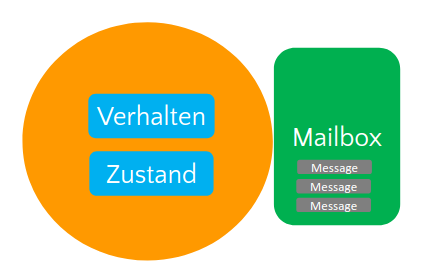
Elemente des Aktor-Modells
- kein geteilter Zustand zwischen Aktoren
- keine Synchronisierung erforderlich
- jeder Aktor hat eigene Mailbox
- eingehende Nachrichten
- Nachrichten werden sequentiell bearbeitet
- Nachrichten werden asynchron zugestellt
- ein Aktor kann neue Aktoren erzeugen
- Verteilung von Teilaufgaben
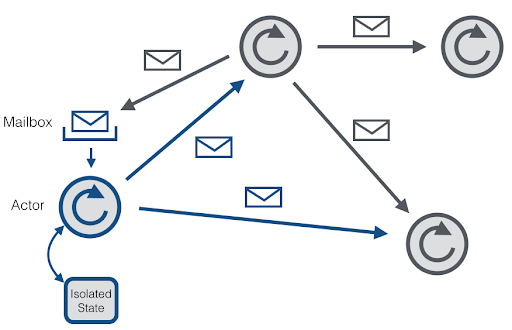
- Aktor kann Nachricht nehmen und verarbeiten (verbrauchen)
- oder unverändert weiterleiten
- Alternativ: Verarbeitung = neue Nachricht(en) erzeugen und weiterleiten
- Aktor kann Nachrichten an sich selber senden
Nachrichten
- Aktor interagieren durch Nachrichtenaustausch
- Nachrichten werden asynchron zugestellt
- empfangender Aktor blockiert nicht bis zum Empfang
- Mailbox \(\neq\) Channel
- mehrere Produzenten für eine Mailbox möglich
- ein Empfänger behandelt die Nachrichten mehrere anderer Aktoren, die in seiner Mailbox ankommen, synchron
- “put” und “take” sind atomare Operationen
- Nachrichten immutable
- Aktor kann Nachricht nehmen und verarbeiten (verbrauchen)
- oder unverändert weiterleiten
- Alternativ: Verarbeitung = neue Nachricht(en) erzeugen und weiterleiten
- Aktor kann Nachrichten an sich selber senden
Aktoren \(\neq\) Threads
- Die Anzahl der Aktoren kann größer sein, als die Zahl der sinnvoll zu behandelnden Threads (wie bei Fibers, Go-Coroutinen etc.)
- Es gibt eine Komponente im Aktor-System (“Dispatcher”), die eine Zuordnung von Aktor zu Thread (z.B. aus einem Threadpool) übernimmt.

Aktoren überwachen Aktoren
Aktor-Programme und Fehler
Aktoren überwachen andere Aktoren (solche “Überwacher” heißen supersivor).
Statt “defensive programming” oder Exception Handling: “let it crash”:
- Worker (Aktor, der konkrete Anwendungsaufgabe umsetzt) ist nur für Verarbeitung korrekter Eingabeparameter gemacht.
- Fehlerbehandlung wird in den Supervisor verschoben.
Vorteile
- Programme sind einfacher (Fehlerbehandlung ausgelagert).
- Da Aktoren getrennt sind und keine Variablen teilen, besteht keine Gefahr, dass mehr als ein Programmteil abstürzt (Worker stürzt ab, Supervisor bleibt).
- Supervisor kann weitergehende Fehlerbehandlungsstrategien auch für unvorhergesehene Situationen implementieren und zentrale Protokollierung vornehmen.
Hierarchie von Error Kernels
Aktoren (Supervisor) überwachen Aktoren (Worker oder Supervisor)
- sie werden über Abstürze informiert
- Ersatz für Execption Handling
- sehr robust
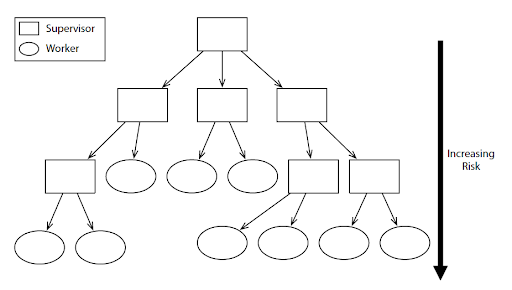
Design Prinzipien für Aktoren
- Ein Aktor sollte nur eine klar abgegrenzte Aufgabe haben (“single responsibility”-Prinzip)
- Spezifische Supervisor: Ein Supervisor sollte nur genau eine Art von Worker überwachen.
- Einfacher Error Kernel: Die Wurzel in der Überwachungshierarchie sollte so einfach wie möglich sein, um Fehler zu vermeiden, die nicht abgefangen werden können.
- Fehler-Zonen: Fehler sollten sich nur auf einen abgegrenzten Teil der Hierarchie von Supervisors/Workers auswirken.
Akka (Java API)
Auf Nachrichten reagieren
- 1
-
Actor erweitert
AbstractLoggingActoroderAbstractActor(ohne Logging) - 2
-
createReceive()-Methode wird überschrieben - 3
-
reagiert auf Nachrichten vom Typ
Greeting - 4
-
“Builder”-Design Pattern für
Receive-Objekt
Auf Nachrichten reagieren
public class NewActor extends AbstractActor {
@Override
public Receive createReceive() {
return receiveBuilder()
.match(Msg1.class, this::receiveMsg1)
.match(Msg2.class, this::receiveMsg2)
.match(Msg3.class, this::receiveMsg3)
.build();
}
private void receiveMsg1(Msg1 msg) {...}
private void receiveMsg2(Msg2 msg) {...}
private void receiveMsg3(Msg3 msg) {...}
}Aktor programmatisch erzeugen
ActorRefist der Basis-Typ für Aktoren in AkkaactorOfist Factory-Methode zum Erzeugen neuer Aktoren- Aktoren werden immer in einem (“Eltern”-) Kontext erzeugt
Akka.system()ist “Wurzel”-Kontext- Auswahl des Aktor-Typs durch
Props.create(…): hier Implementierungsklasse des Aktors angeben – z. B.MyActor - optional kann als zweiter Parameter von
actorOfein Akka-interner Name angegeben werden, über den der Aktor identifiziert werden kann
Kind-Aktor in Eltern-Aktor erzeugen
Aktor-Hierarchie

Aktor-Hierarchie
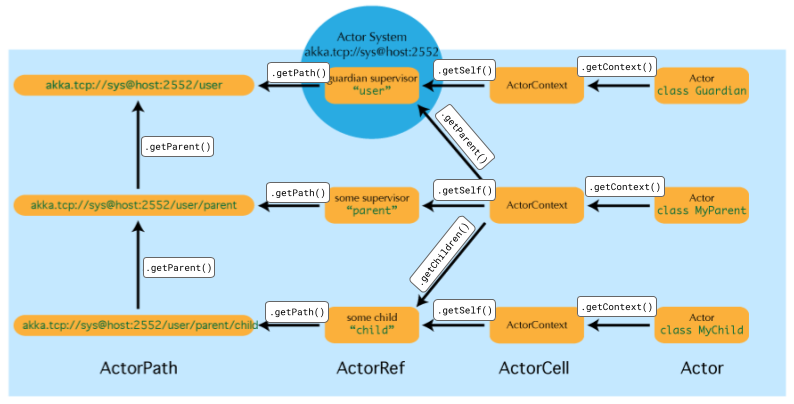
https://doc.akka.io/docs/akka/current/general/ActorPath.png (abgewandelt)
Nachrichtenversand
getSender(): von welchem Aktor kam die letzte Nachricht (die gerade behandelt wird)?
Nachrichtenversand
import static akka.pattern.PatternsCS.ask;
CompletableFuture<Object> future1 = ask(actorA, "request 1", 1000);
CompletableFuture<Object> future2 = ask(actorB, "request 2", 1000);
CompletableFuture<Result> transformed =
CompletableFuture.allOf(future1, future2).thenApply(v -> {
String x = (String) future1.join();
String s = (String) future2.join();
return new Result(x, s);
});- Niemals ein CompletableFuture als Nachricht versenden: Wenn Aktoren auf unterschiedlichen Rechnern sind, müsste das Future zum Versand serialisiert werden, was nicht funktioniert.
Design-Prinzipien für Nachrichtenversand
- “Fire-and-Forget” statt “Request-Reply”: Nachrichten sollten tendenziell eher nicht auf Aufforderung versendet werden, sondern aufgrund eines Ereignisses/situativen Zustands.
- tell vor ask bevorzugen: mit tell kann genauso ein Request-Reply Kommunikationsmuster umgesetzt werden: In vielen Fällen ist es nicht erforderlich eine Korrelation zwischen Anfrage und Antwort herzustellen.
- besser: Frage in Antwort wiederholen (bzw. wesentliche Elemente daraus), dann kann der Empfänger sie unabhängig von seiner Anfrage interpretieren
- ermöglicht auch das Antworten ans andere Aktoren als den ursprünglichen Anfrager
Monitoring
public class WatchActor extends AbstractActor {
ActorRef child = getContext().actorOf(
Props.create(ListenerActor.class), "listener");
ActorRef lastSender;
public WatchActor() {
getContext().watch(this.child);
}
@Override
public Receive createReceive() {
return receiveBuilder()
.match(PoisonPill.class, (msg) -> {
getContext().stop(this.child);
this.lastSender = getSender(); })
.match(Terminated.class, (msg) -> {
if (msg.getActor() == this.child) {
this.lastSender.tell("finished", null);
} })
.build();
}
}Parallele Suche eines Suchstrings in einigen wenigen Textdateien
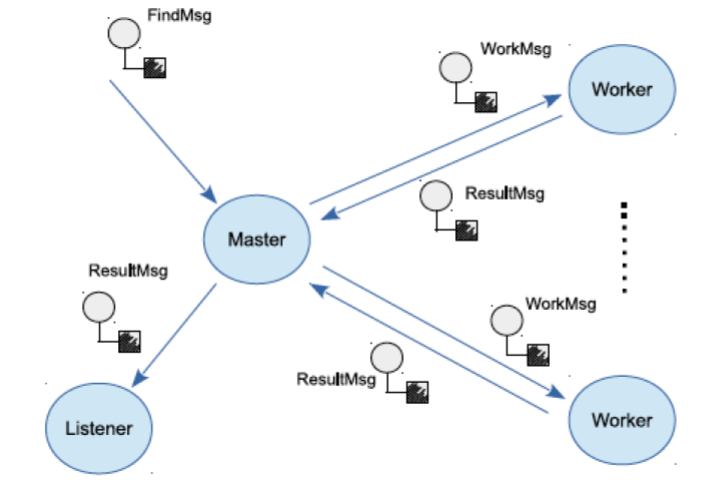
Hettel und Tran (2016)
Parallele Suche eines Suchstrings in einigen wenigen Textdateien
- Master erzeugt Listener
FindMsgmit drei zu durchsuchenden Dateien trifft beim Master ein- Master erzeugt jeweils Worker und sendet eine
WorkMsgan ihn - Worker durchsucht Datei aus
WorkMsgund sendet Ergebnisse alsResultMsgan Master zurück - Master sammelt alle Antworten, erzeugt daraus eine Gesamt-
ResultMsgund schickt sie an den Listener - Listener gibt Gesamtergebnis auf Konsole aus und terminiert Anwendung
Laboraufgabe “Parallele Suche eines Suchstrings in einigen wenigen Textdateien”
- Projekt:
pp.11.01-FindWords - Bearbeitungszeit: 25 Minuten
- Musterlösung: 15 Minuten
- Kompatibilität: mindestens Java SE 16
Router
Lastverteilung über Router
Abgrenzung Router zu Aktor
- Router ähnlich zu Aktoren
- kein eigener Zustand und Verhalten
- Eingang für eine Reihe nachgeordneter Aktoren (“Routees”)
Routee
- in der Regel gleichartig (z. B. von derselben Klasse)
- verarbeiten prinzipiell dieselben Nachrichtentypen
- Router kennt seine Routees
Nachrichtenversand über Router
- Nachricht an Routee wird nicht direkt geschickt, sondern über Router (“route”)
- Router ändert Nachricht nicht, Absender bleibt ursprünglicher Sender
- Router entscheidet aufgrund Entscheidungslogik, an welchen Routee weitergeleitet wird
- Router dient als “Load-Balancer” für Routees
Round-Robin Routing
akka.routing.*
>> RoundRobinRoutingLogic
RandomRoutingLogic
SmallestMailboxRoutingLogic
BroadcastRoutingLogic
ScatterGatherFirstCompletedRoutingLogic
TailChoppingRoutingLogic
ConsistentHashingRoutingLogic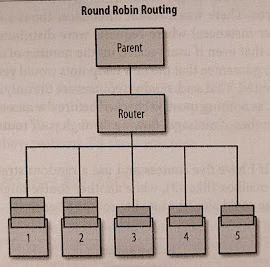
Allen (2013, 4)
Random Routing
akka.routing.*
RoundRobinRoutingLogic
>> RandomRoutingLogic
SmallestMailboxRoutingLogic
BroadcastRoutingLogic
ScatterGatherFirstCompletedRoutingLogic
TailChoppingRoutingLogic
ConsistentHashingRoutingLogic
Allen (2013, 3)
Smallest Mailbox Routing
akka.routing.*
RoundRobinRoutingLogic
RandomRoutingLogic
>> SmallestMailboxRoutingLogic
BroadcastRoutingLogic
ScatterGatherFirstCompletedRoutingLogic
TailChoppingRoutingLogic
ConsistentHashingRoutingLogic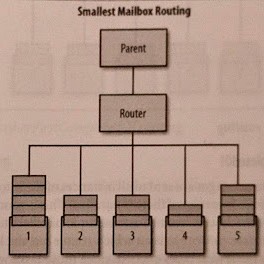
Allen (2013, 5)
Broadcast Routing
akka.routing.*
RoundRobinRoutingLogic
RandomRoutingLogic
SmallestMailboxRoutingLogic
>> BroadcastRoutingLogic
ScatterGatherFirstCompletedRoutingLogic
TailChoppingRoutingLogic
ConsistentHashingRoutingLogic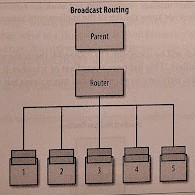
Allen (2013, 6)
Scatter Gather First Completed Routing
akka.routing.*
RoundRobinRoutingLogic
RandomRoutingLogic
SmallestMailboxRoutingLogic
BroadcastRoutingLogic
>> ScatterGatherFirstCompletedRoutingLogic
TailChoppingRoutingLogic
ConsistentHashingRoutingLogic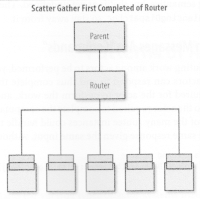
Allen (2013, 7)
Router-Verwendung
var routees = new ArrayList<Routee>();
for (var i = 0; i < 5; i++) {
var routee = getContext().actorOf(Props.create(Worker.class));
getContext().watch(routee);
routees.add(new ActorRefRoutee(routee));
}
var router = new Router(new RoundRobinRoutingLogic(), routees);
// ...
router.route(message, getSelf());Parallele Suche eines Suchstrings in sehr vielen Textdateien mit einem Router

Hettel und Tran (2016)
Parallele Suche eines Suchstrings in sehr vielen Textdateien mit einem Router
- Master erzeugt am Anfang Listener und alle Worker
- Master erzeugt dann einen Router, dem die Worker als Routees übergeben werden
- eine
FindMsgkommt beim Master an - die drei darin enthaltenen Dateien werden vom Master als
WorkMsgan den Router geschickt. - Router sendet erste und zweite
WorkMsgan w1 und w2 - die dritte
WorkMsggeht vom Router wieder wegen Round Robin-Logik an w1 - Master sammelt drei
ResultMsgein und sendet Gesamtergebnis alsResultMsgan Listener
Laboraufgabe “Parallele Suche eines Suchstrings in sehr vielen Textdateien mit einem Router”
- Projekt:
pp.11.02-RouterFindWords - Bearbeitungszeit: 35 Minuten
- Musterlösung: 15 Minuten
- Kompatibilität: mindestens Java SE 16
Kopplung von Router und Routees
Gruppe
Im Fall einer Router-Group sind Router und Routees weniger eng gekoppelt:
- Der Router erzeugt “seine” Routees-Aktoren nicht selber, sondern bekommt sie mitgeteilt.
- Er überwacht die Routees nicht selber.
Pool
Im Fall eines Router-Pools sind Router und Routees enger gekoppelt als bei einer Gruppe:
- Der Router erzeugt “seine” Routees-Aktoren selber und überwacht sie.
- Sollte ein Routee terminieren, entfernt der Router sie aus seiner Routee-Liste.
Referenzen
Allen, Jamie. 2013. Effective Akka. Sebastopol: O’Reilly.
Apache Software Foundation. 2021. Example Network of Several Actors (Apache Flink Confluence Site: Akka and Actors). 15. März. https://cwiki.apache.org/confluence/download/attachments/53741538/actorNetwork.png (zugegriffen: 20. Dezember 2021).
Butcher, Paul. 2014. Seven Concurrency Models in Seven Weeks. When Threads Unravel. Dallas: The Pragmatic Programmers.
Hettel, Jörg und Manh Tien Tran. 2016. Nebenläufige Programmierung mit Java. Konzepte und Programmiermodelle für Multicore-Systeme. Heildelberg: dpunkt.verlag.
Hewitt, Carl, Peter Bishop und Richard Steiger. 1973. A Universal Modular ACTOR Formalism for Artificial Intelligence. In: Proceedings of the Third International Joint Conference on Artificial Intelligence, 235–245. Stanford, 20–23. August. http://www.ijcai.org/Proceedings/73/Papers/027B.pdf (zugegriffen: 20. Dezember 2021).
